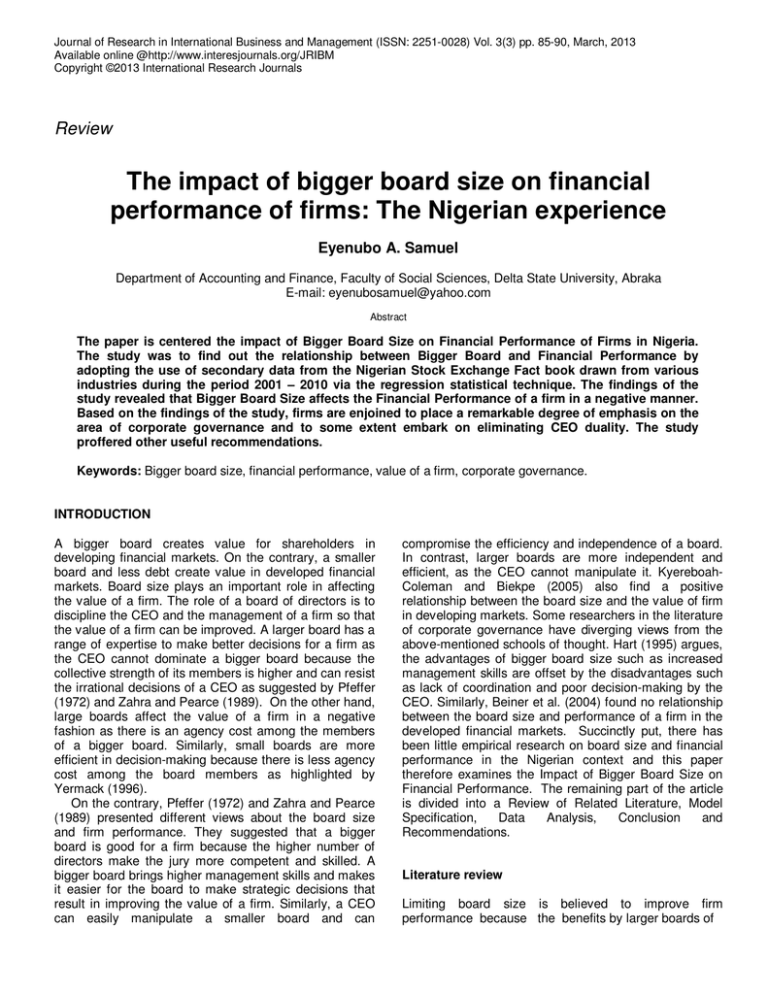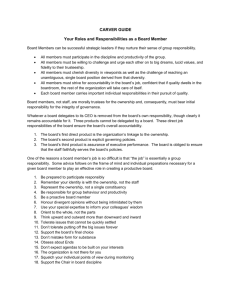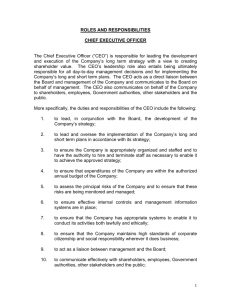Document 14249164
advertisement

Journal of Research in International Business and Management (ISSN: 2251-0028) Vol. 3(3) pp. 85-90, March, 2013 Available online @http://www.interesjournals.org/JRIBM Copyright ©2013 International Research Journals Review The impact of bigger board size on financial performance of firms: The Nigerian experience Eyenubo A. Samuel Department of Accounting and Finance, Faculty of Social Sciences, Delta State University, Abraka E-mail: eyenubosamuel@yahoo.com Abstract The paper is centered the impact of Bigger Board Size on Financial Performance of Firms in Nigeria. The study was to find out the relationship between Bigger Board and Financial Performance by adopting the use of secondary data from the Nigerian Stock Exchange Fact book drawn from various industries during the period 2001 – 2010 via the regression statistical technique. The findings of the study revealed that Bigger Board Size affects the Financial Performance of a firm in a negative manner. Based on the findings of the study, firms are enjoined to place a remarkable degree of emphasis on the area of corporate governance and to some extent embark on eliminating CEO duality. The study proffered other useful recommendations. Keywords: Bigger board size, financial performance, value of a firm, corporate governance. INTRODUCTION A bigger board creates value for shareholders in developing financial markets. On the contrary, a smaller board and less debt create value in developed financial markets. Board size plays an important role in affecting the value of a firm. The role of a board of directors is to discipline the CEO and the management of a firm so that the value of a firm can be improved. A larger board has a range of expertise to make better decisions for a firm as the CEO cannot dominate a bigger board because the collective strength of its members is higher and can resist the irrational decisions of a CEO as suggested by Pfeffer (1972) and Zahra and Pearce (1989). On the other hand, large boards affect the value of a firm in a negative fashion as there is an agency cost among the members of a bigger board. Similarly, small boards are more efficient in decision-making because there is less agency cost among the board members as highlighted by Yermack (1996). On the contrary, Pfeffer (1972) and Zahra and Pearce (1989) presented different views about the board size and firm performance. They suggested that a bigger board is good for a firm because the higher number of directors make the jury more competent and skilled. A bigger board brings higher management skills and makes it easier for the board to make strategic decisions that result in improving the value of a firm. Similarly, a CEO can easily manipulate a smaller board and can compromise the efficiency and independence of a board. In contrast, larger boards are more independent and efficient, as the CEO cannot manipulate it. KyereboahColeman and Biekpe (2005) also find a positive relationship between the board size and the value of firm in developing markets. Some researchers in the literature of corporate governance have diverging views from the above-mentioned schools of thought. Hart (1995) argues, the advantages of bigger board size such as increased management skills are offset by the disadvantages such as lack of coordination and poor decision-making by the CEO. Similarly, Beiner et al. (2004) found no relationship between the board size and performance of a firm in the developed financial markets. Succinctly put, there has been little empirical research on board size and financial performance in the Nigerian context and this paper therefore examines the Impact of Bigger Board Size on Financial Performance. The remaining part of the article is divided into a Review of Related Literature, Model Specification, Data Analysis, Conclusion and Recommendations. Literature review Limiting board size is believed to improve firm performance because the benefits by larger boards of 86 J. Res. Int. Bus. Manag. increased monitoring are outweighed by the poorer communication and decision-making of larger groups (Lipton and Lorsch 1992; Jensen 1993). Consistent with this notion, Yermack (1996) documents an inverse relation between board size and profitability, asset utilization, and Tobin’s Q. Anderson et al. (2004) show that the cost of debt is lower for larger boards, presumably because creditors view these firms as having more effective monitors of their financial accounting processes. Klein (2002) documents a negative relation between earnings management and audit committee independence, and Anderson et al. (2004) find that entirely independent audit committees have lower debt financing costs. Frankel, Johnson and Nelson (2002) show a negative relation between earnings management and auditor independence (based on audit versus nonaudit fees), but Ashbaugh, Lafond and Mayhew (2003) and Larcker and Richardson (2004) dispute their evidence. Kinney, Palmrose and Scholz (2004) find no relation between earnings restatements and fees paid for financial information systems design and implementation or internal audit services, and Agrawal and Chadha (2005) find no relation between either audit committee independence or the extent auditors provide non-audit services with the probability a firm restates its earnings. Several studies have examined the separation of CEO and chairman, positing that agency problems are higher when the same person holds both positions. Using a sample of 452 firms in the annual Forbes magazine rankings of the 500 largest U.S. public firms between 1984 and 1991, Yermack (1996) shows that firms are more valuable when the CEO and board chair positions are separate. Core, Holthausen and Larcker (1999) find that CEO compensation is lower when the CEO and board chair positions are separate. Consistent with Yermack (1996), we show that firms are more valuable when the CEOand board chair positions are separate. Botosan and Plumlee (2001) find a material effect of expensing stock options on return on assets. They use Fortune’s list of the 100 fastest growing companies as of September 1999, and compute the effect of expensing stock options on firms’ operating performance. In contrast, we use a larger sample and compare firms that do and do not expense. Based on Fortune 1000 firms during 1997-1999, Fich and Shivdasani (2004) find that firms with director stock option plans have higher market to book ratios, higher profitability (as proxied by operating return on assets, return on sales and asset turnover), and they document a positive stock market reaction when firms announce stock option plans for their directors. In contrast, we find no evidence that operating performance or firm valuation is positively related either to stock option expensing or to directors receiving some or all of their fees in stock. Gompers, Ishii and Metrick (2003) [hereafter GIM] use Investor Responsibility Research Centre (IRRC) data, and conclude that firms with fewer shareholder rights have lower firm valuations and lower stock returns. GIM classify 24 governance factors into five groups: tactics for delaying hostile takeover, voting rights, director/ officer protection, other takeover defenses, and state laws. Most of these factors are antitakeover measures so G-Index is effectively an index of anti-takeover protection (Cremers and Nair, 2003) rather than a broad index of governance. The mechanism proposed to deal with the agency problem is board size. There are arguments in favour of small board size. First, Yermack (1996), in a review of the earlier work of Monks and Minow (1995), argues that large boardrooms tend to beslow in making decisions, and hence can be an obstacle to change. A second reason forthe support for small board size is that directors rarely criticize the policies of top managers and that this problem tends to increase with the number of directors (Yermack, 1996; Lipton and Lorsch, 1992). Yermack (1996) examines the relation between board size and firm performance, concluding that the smaller the board size the better the performance, and proposing an optimal board size of ten or fewer. John and Senbet (1998) maintain that the findings of Yermack have important implications, not least because they may call for the need to depend on forces outside the market system in order to determine the size of the board. The role of the CEO and the chairman is important in improving the value of a firm. A single person holding both roles (CEO duality) has an important bearing on the value of a firm and there are two schools of thought in this regard. Fama and Jensen (1983) supported agency theory and suggested that a single person holding the positions of CEO and chairman cannot monitor the organization well. In addition, a person being head of the board and operations is not a healthy sign keeping in mind the principles of corporate governance. They further suggest the agency problem increases when a single person holds both these important roles. The shareholders also bear higher monitoring costs in the absence of the chairman in a firm. The second school of thought about the CEO duality is called stewardship theory. The supporters of this theory are Stoeberl and Sherony (1985), Alexander, Fennell and Halpern (1993) and Brickley, Coles and Jarrell (1997). They suggest that CEO duality leads to a higher performance as it provides strength to the organization. The CEO cannot plan and make the decisions beneficial for the shareholders in the case of contention between the CEO and Chairman. The dual leadership firm may lack proper direction affecting the shareholders wealth in a negative manner. Bhagat and Jefferis (2002) argue that the interests of shareholders and the CEO can be aligned with each other obliging the CEO to work for the benefit of shareholders and to create value for them. This type of benefit to shareholders is wasted in the case of the firms having a non-dual structure of leadership. The third school of thought about the relationship between the value of a firm and CEO duality suggests the lack of a Eyenubo 87 significant relationship between the two. Chaganti, Mahajan and Sharma (1985) and Daily and Dalton (1992, 1993) find no relationship between the firms’ performance and CEO duality. The diverging views and facts about the role of majority shareholders, debt, CEO duality and board size in affecting the value of a firm in developing and developed financial markets, suggest the need for a new study to shed light on the true comparative roles of these instruments in developing and developed countries. The bigger board is involved in passive monitoring and board members do not perform at an optimal level to improve value of the shareholders. A bigger board brings higher management skills and makes it easier for the board to make strategic decisions that result in improving the value of a firm. Similarly, a CEO can easily manipulate a smaller board and can compromise the efficiency and independence of a board. In contrast, larger boards are more independent and efficient, as the CEO cannot manipulate it. KyereboahColeman and Biekpe (2005) also find a positive relationship between the board size and the value of firm in developing markets. Some researchers in the literature of corporate governance have diverging views from the above-mentioned schools of thought. Hart (1995) argues, the advantages of bigger board size such as increased management skills are offset by the disadvantages such as lack of coordination and poor decision-making by the CEO. Similarly, Beiner et al. (2004) found no relationship between the board size and performance of a firm in the developed financial markets. The role of the CEO and the chairman is important in improving the value of a firm. A single person holding both roles (CEO duality) has an important bearing on the value of a firm and there are two schools of thought in this regard. Fama and Jensen (1983) supported agency theory and suggested that a single person holding the positions of CEO and chairman cannot monitor the organization well. In addition, a person being head of the board and operations is not a healthy sign keeping in mind the principles of corporate governance. They further suggest the agency problem increases when a single person holds both these important roles. The shareholders also bear higher monitoring costs in the absence of the chairman in a firm. Additionally, Brown and Caylor found that firms with independent boards had higher returns on equity, higher profit margins, larger dividend yields and larger stock repurchase. They went on to suggest that limiting board size leads to improved firm performance as the increased monitoring benefits of larger boards were outweighed by poorer communication and decision‐making. board size and financial performance of firms Hi: There is significant relationship between board size and financial performance of firms Model Specification Regression will be used as a tool for hypotheses testing and to reveal the relationship between Bigger Board and the Value of Firm Financial Performance. The regression will specify the relationship among the dependent variable, independent variable. The general representation of the model is given in the equation below. The general representation of the model is as follows: Yt= C + β1tlogX1t+ Ut Where: Yt(regrassand) = Net Profit; C = intercept; βt(β1– β5) = slope of the independent variable; Xt(regressor) = independent variables; t = periods; Ut = error term; β1 = Bigger Board DATA ANALYSIS NPAT = 11.887NPAT + 6.7400BRDSIZE (7.065) (5.463) R2 = 0.96 R2 Adjusted = 0.95 F-statistic = 126.548 f-critical = 4.04 t-statistic = 6.740 t-critical = 2.021 Prob(F-statistic) = 0.000000 DW = 2.250 df = 1 – Numerator and 48 Denominator Level of Sign = 0.05% _ R2/R2 Adjusted The R2 represents the coefficient of determination and goodness of fit test. The R2 suggests that 96% of the total variation in the dependent variable (NPAT) has been explained by BRDSIZE and this is a good fit since the unexplained variation is just 4% (1 – 0.96). The R2 which is the adjusted R2 for degrees of freedom suggests that 95% of the changes in the dependent variable (NPAT) have been explained by BRDSIZE. Hypothesis of the Study F-test Ho: There is no significant relationship between board The f-test is used to test the overall significance of the 88 J. Res. Int. Bus. Manag. model and the hypotheses. The decision rule of the f-test is that if f-calculated > f-critical, we reject the null hypothesis and accept the alternative hypothesis. The opposite is the case if the f-calculated < f-critical. The result revealed that f-statistic with value 126.548 is > fcritical with value 4.04 and this suggest that we reject the null hypothesis and accept the alternative hypothesis which states that bigger board does affect the value of a firm financial performance in a negative manner. T-test The t-test is used to test the statistical significance of each independent variable in explaining the changes in the dependent variable. The t-test shows the predictive power of each independent variable. The decision rule of the t-test is that if t-calculated > t-critical, it suggests that the particular independent variable is statistically significant in explaining the changes in the dependent variables. The t-test suggests that the t-calculated with value 6.740 is > t-critical with value 2.021 and this mean that BRDSIZE is statistically significant in explaining the changes in NPAT. make better decisions for a firm as the CEO cannot dominate a bigger board because the collective strength of its members is higher and can resist the irrational decisions of a CEO. RECOMMENDATIONS Based on the findings of the study, firms are enjoined to place a remarkable degree of emphasis on the area of corporate governance and to some extent embark on eliminating CEO duality. It is also recommended that a larger data set may result in a different model of the relationship between CEO Duality and Financial Performance of firms in Nigeria. The inclusion of new corporate governance instruments could result in additional Edge worth combinations of the internal corporate governance mechanism. Similarly, corporate governance instruments such as capital structure, shareholding by the management, CEO tenure, banking efficiency, political regime and executive remuneration can be used to test the relationship between bigger board size and the financial performance of firms. REFERENCES Dw The Durbin Watson test is used to test for the presence or absence of first order serial correlation in the model. The Durbin Watson test with value 2.250suggests that the model does not show support for the existence of first order serial correlation. Signs/Magnitude The Signs and Magnitude is used to show the linear relationship that exists between the dependent and independent variable whether there are positive or negative relationships. The result shows that BRDSIZE have a positive linear relationship with the NPAT. That is, an increase in the BRDSIZE by 6.7400units will increase the NPAT by 11.8870units. CONCLUSION This study is aimed at examining the “Impact of Bigger Board Size and the Financial Performance of Firms in Nigeria”. To accomplish this task, 50 firms quoted on the Nigerian Stock Exchange were used during the period 2001 - 2010. Based on the findings of the study, we have concluded that bigger board size affects the value of a firm in a negative manner, which tend to be harmful to financial performance of firms and as well as corporate governance. A bigger board has a range of expertise to Beiner S, Drobetz W, Schmid F, Zimmermann H (2004). ‘Is board size an independent corporate governance mechanism?’, Kyklos, 57(3) Bhagat S, Jefferis R (2002). The Econometrics of Corporate Governance Studies, MIT Press, Cambridge. Brickley J, Coles J, Jarrell G (1997). ‘Leadership structure: separating the CEO and chairman of the board’, J. Corporat. Finan.; 3(4). Chaganti R, Mahajan V, Sharma S (1985). ‘Corporate board size, composition and corporate failures in retailing industry’ J. Manag. Stud.: 22. Daily C, Dalton D (1992).‘The relationship between governance structure and corporate performance in entrepreneurial firms’, J. Bus. Ventur.; 7(5). Daily C, Dalton D (1993). ‘Board of directors leadership and structure: control and performance implications’, Entrepreneurship: Theory and Practice, 17(3). Fama E, Jensen M (1983). ‘Separation of ownership and control’, J. Law and Econom.; 26(2). Gompers P, Ishii J, Metric A (2003). ‘Corporate governance and equity prices’, Quart. J. Econom.; 118, No. 1. Jensen M (1993). ‘The modern industrial revolution, exit, and the failure of internalcontrol systems’, J. Finan.; 48(3). Kyereboah-Coleman A, Biekpe N (2005). ‘The relationship between board size boardcomposition, CEO duality, and firm performance: experience from Ghana’, working paper, University of Stellenbosch Business School, Cape Town. Larcker D, Richardson S, Tuna I (2004). ‘How important is corporate governance? ’working paper, University of Pennsylvania, Philadelphia. Lipton M, Lorsch J (1992). ‘A modest proposal for improved corporate governance’,Business Lawyer, Vol. 48, No. 1. Monks R, Minow N (1995). Corporate Governance, 2nd edn, Blackwell Publishers, Oxford. Stoeberl P, Sherony B (1985). ‘Board efficiency and effectiveness’, in E Matter and MBall (eds) Handbook for Corporate Directors, McGraw Hill, New York. Yermack D (1996). ‘Higher market valuation of companies with a small board of directors’, J. Financ. Econom.; 40(2). Zahra S, Pearce J (1989). ‘Boards of directors and corporate financial performance: a review and integrative model’, J. Manag.; 15(2). Eyenubo 89 APPENDIX Regression Result on Board Size Descriptive Statistics Mean Std. Deviation N 4.31E5 231499.200 50 7.6000E2 156.16579 50 NPAT BRDSIZE Correlations NPAT BRDSIZE Pearson Correlation NPAT 1.000 .106 BRDSIZE .106 1.000 NPAT . .231 BRDSIZE .231 . NPAT 50 50 BRDSIZE 50 50 Sig. (1-tailed) N Variables Entered/Removedb Model Variables Entered Variables Removed Method . Enter a 1 BRDSIZE a. All requested variables entered. b. Dependent Variable: NPAT Model Summaryb Model 1 R .962a Change Statistics R Adjusted R Std. Error of DurbinSquare Square the Estimate R Square Change F Change df1 df2 Sig. F Change Watson .096 .095 232575.546 .094 126.548 1 48 12.463 a. Predictors: (Constant), BRDSIZE b. Dependent Variable: NPAT ANOVAb Model 1 Sum of Squares df Mean Square Regression 2.962E10 1 2.962E10 Residual 2.596E12 48 5.409E10 Total 2.626E12 49 a. Predictors: (Constant), BRDSIZE b. Dependent Variable: NPAT F Sig. 126.548 12.463a 2.250 90 J. Res. Int. Bus. Manag. APPENDIX CONTINUE Coefficientsa Unstandardized Coefficients Standardized Coefficients Model 1 B Std. Error (Constant) 311424.389 165005.307 BRDSIZE 157.426 212.755 Beta t 11.887 7.065 .106 6.740 a. Dependent Variable: NPAT Residuals Statisticsa Minimum Maximum Mean Std. Deviation N 3.67E5 4.61E5 4.31E5 24584.567 50 -3.039E5 4.151E5 .000 230190.093 50 Std. Predicted Value -2.625 1.217 .000 1.000 50 Std. Residual -1.307 1.785 .000 .990 50 Predicted Value Residual a. Dependent Variable: NPAT Sig. 5.463



